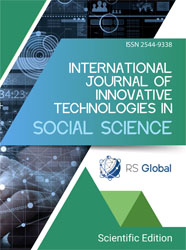INTEGRATION OF BLOCKCHAIN TECHNOLOGIES AND MACHINE LEARNING WITH DEEP ANALYSIS
Abstract
The successful development of the digital economy, which we can observe since the advent of the internet, is closely related to progress in several "frontier technologies" (frontier technologies), among which the most important, according to the scientific community and international organizations, are such software-oriented technologies as blockchain, Big Data Analytics (Big Data), Artificial Intelligence (AI) and cloud Computing (Cloud Computing), as well as specialized machine-oriented equipment: 3D printers, internet of Things devices (Internet of things Things, IoT), automation and robotics. Significant progress in the application of these technologies contributes to the growth of production capabilities, labor productivity, and capital return of both digital companies and enterprises of the non-digital economy while transforming their established business models and principles of generating income and expenses of companies. This makes it necessary to study the above technologies in detail from the point of view of analyzing their essence, role, and potential for use in various spheres of economic life. Although the term "blockchain" has recently entered scientific and public use, the idea of the technology appeared in the late 1980s, namely in 1989. Lamport proposed "a model for achieving consensus on results in a network of computers, where computers or the network itself can be unreliable". In 2008, Satoshi Nakamoto proposed the concept of using a decentralized computer network to operate a P2P electronic money system. In the article "Bitcoin: a Peer-to-Peer Electronic Cash System" published on the internet, the innovator described the algorithm of functioning of the Bitcoin cryptocurrency as a completely independent electronic cash system from a single issue Center, which does not require the trust (mediation) of a third party, but relies on direct operations between the parties to the transaction, protected by cryptographic encryption.
References
Ahmad, R.W., Hasan, H., Jayaraman, R., Salah, K., Omar, M.: Blockchain applications and architectures for port operations and logistics management. Res. Transp. Business Manag. (2021a). https://doi.org/10.1016/j.rtbm.2021.100620
Ahmad, R.W., Salah, K., Jayaraman, R., Yaqoob, I., Ellahham, S., Omar, M.: The role of blockchain technology in telehealth and telemedicine. Int. J. Med. Inf. 148, 104399 (2021b)
Al Ridhawi, I., Aloqaily, M., Jararweh, Y.: An incentive-based mechanism for volunteer computing using blockchain. ACM Trans. Internet Technol. 21(4), 1–22 (2021)
Ayyoubzadeh, S.M., Ayyoubzadeh, S.M., Zahedi, H., Ahmadi, M., Kalhori, S.R.N.: Predicting COVID-19 incidence through analysis of google trends data in Iran: data mining and deep learning pilot study. JMIR Public Health Surv. 6(2), e18828 (2020)
Bach, L.M., Mihaljevic, B., Zagar, M.: Comparative analysis of blockchain consensus algorithms. In: 41st International Convention on Information and Communication Technology, Electronics and Microelectronics (MIPRO). IEEE 2018, pp. 1545–1550 (2018)
Berman, D.S., Buczak, A.L., Chavis, J.S., Corbett, C.L.: A survey of Deep learning methods for cyber security. Information 10(4), 122 (2019)
Brown, T.B., Mann, B., Ryder, N., Subbiah, M., Kaplan, J., Dhariwal, P., Neelakantan, A., Shyam, P., Sastry, G., Askell A., et al.: Language models are few-shot learners. arXiv preprint arXiv:2005.14165, 2020
Hassan, T., Shafay, M., Akçay, S., Khan, S., Bennamoun, M., Damiani, E., Werghi, N.: Meta-transfer learning driven tensor-shot detector for the autonomous localization and recognition of concealed baggage threats, Nov 2020. https://www.mdpi.com/1424-8220/20/22/6450
Lawrence, S., Giles, C.L.: Overfitting and Neural networks: conjugate gradient and backpropagation. In: Proceedings of the IEEE-INNS-ENNS International Joint Conference on Neural Networks. IJCNN 2000. Neural Computing: New Challenges and Perspectives for the New Millenniu, vol. 1. IEEE, 2000, pp. 114–119
Narayan, S., Tagliarini, G.: An analysis of underfitting in MLP networks. In: Proceedings. 2005 IEEE International Joint Conference on Neural Networks, 2005., vol. 2. IEEE, 2005, pp. 984–988
Oh, Y., Park, S., Ye, J.C.: Deep learning COVID-19 features on CXR using limited training data sets. IEEE Trans. Med. imaging 39(8), 2688–2700 (2020)
Ren, W., Hu, J., Zhu, T., Ren, Y., Choo, K.-K.R.: A flexible method to defend against computationally resourceful miners in blockchain Proof-of-work. Inf. Sci. 507, 161–171 (2020)
Shafay, M., Hassan, T., Velayudhan, D., Damiani, E., Werghi, N.: Deep fusion driven semantic segmentation for the automatic recognition of concealed contraband items. In: SoCPaR, 2020, pp. 550–559
Shiraz, M., Gani, A., Ahmad, R.W., Shah, S.A.A., Karim, A., Rahman, Z.A.: A lightweight distributed framework for computational offloading in mobile cloud computing. PLoS ONE 9(8), e102270-9 (2014)
Shuja, J., Alanazi, E., Alasmary, W., Alashaikh, A.: COVID-19 open source data sets: a comprehensive survey. Appl. Intell. 51(3), 1296–1325 (2021)
Shuja, J., Bilal, K., Alasmary, W., Sinky, H., Alanazi, E.: Applying machine learning techniques for caching in edge networks: a comprehensive survey, arXiv preprint arXiv:2006.16864, 2020
Tan, L., Xiao, H., Yu, K., Aloqaily, M., Jararweh, Y.: A blockchain-empowered crowdsourcing system for 5g-enabled smart cities. Comput. Stand. Interfaces 76, 103517 (2021)
Wang, L., Von Laszewski, G., Younge, A., He, X., Kunze, M., Tao, J., Fu, C.: Cloud computing: a perspective study. New Gen. Comput. 28(2), 137–146 (2010)
Zheng, Z., Xie, S., Dai, H.-N., Chen, W., Chen, X., Weng, J., Imran, M.: An overview on smart contracts: Challenges, advances and platforms. Fut. Gen. Comput. Syst. 105, 475–491 (2020)
Views:
480
Downloads:
350
Copyright (c) 2022 Dziatkovskii Anton

This work is licensed under a Creative Commons Attribution 4.0 International License.
All articles are published in open-access and licensed under a Creative Commons Attribution 4.0 International License (CC BY 4.0). Hence, authors retain copyright to the content of the articles.
CC BY 4.0 License allows content to be copied, adapted, displayed, distributed, re-published or otherwise re-used for any purpose including for adaptation and commercial use provided the content is attributed.











